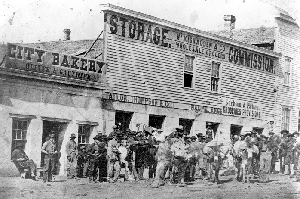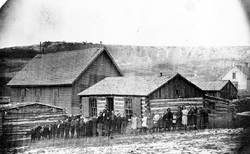Virginia City History
Updated: August 21, 2020

Virginia City, 1863:
Six men from Bannack were on their way to look for gold in the Yellowstone gold fields when a band from the Crow tribe captured them. One of the six men, William Fairweather, put a rattlesnake in his shirt. His bravery impressed the Crow so much they agreed after several days to let the men go. The Crow made the men promise not to continue on to the Yellowstone, so they started back for Bannack.
They camped in a gulch (a big ditch) by a creek lined with trees called alders. They were only looking for enough gold to buy tobacco back in Bannack, but they found the world's biggest surface field of gold at Alder Gulch. They tried not to let anyone know what they'd found, but word got out, and people rushed to the gulch. Only three weeks later, Virginia City was a thriving town. Some of the log cabins built that first month are still there. By fall, between 7,000 and 10,000 people lived around Virginia City.
In the following months, "Road Agents," a gang of thieves and murderers, terrorized miners and shippers of gold and other valuables throughout southwest Montana. They would ride from a hideout called Robbers' Roost outside Nevada City to attack stagecoaches and people as far away as modern-day Missoula, 200 miles.
Sheriff Henry Plummer was the law officer for both Bannack and Virginia City. Many people came to think that Plummer did nothing to stop the gang, called "The Innocents," because he was secretly their leader. People were afraid to do anything about it because the gang had spies everywhere and would know who worked against them. Finally, one event made local people so angry that they decided to do something.

A man in Nevada City named George Ives was accused of killing and robbing a well-liked young man named Nicholas Tabalt. Finally, citizens of Bannack, Virginia City, and Nevada City decided they'd had enough. The people of Nevada City put together their own court outdoors in the December cold and brought Ives to trial.
A man who would become famous in Montana history, William Fisk Sanders, was chosen as prosecutor, to accuse Ives and prove him guilty. Some say Sheriff Plummer hired the best lawyers in the area to defend Ives. Ives was still found guilty and hanged. For the first time, a road agent had been punished for his crimes.
One of Ives' friends told Sanders that he would be killed for being part of the trial. The men who had put the trial together met in secret, in Virginia City, to decide what to do. These men formed a Vigilance Committee to wipe out the road agents. On December 23, 1863, they gathered on the top floor of the Kiskadden Barn to sign an oath. It said:
"We the undersigned uniting ourselves in a party for the laudable purposes of arresting thieves and murderers and recovering stolen property do pledge ourselves and our sacred honor each to all others and solemnly swear that we will reveal no secrets, violate no laws of and never desert each other or our standards of justice so help us God as witness our hand and seal this 23 of December AD 1863."
Members of the committee were called Vigilantes (Vidge-uh-lanteez). The Vigilantes formed their own system of justice. When they caught a road agent, they hanged him, often without a trial. The Vigilantes made a list of gang members, with names taken from a man who admitted he was a road agent and said Plummer was their leader.
Three weeks after the Vigilance Committee was formed, over 24 of the suspected road agents had been hanged. Sheriff Henry Plummer was hanged in Bannack. The graves of five men hanged as road agents are in Boot Hill Cemetery above Virginia City. The rest of the suspected gang members ran for their lives. The robberies and murders stopped.

The Vigilantes took the numbers "3-7-77" as their sign. People disagree about what it was supposed to mean. When Vigilantes wrote it on the home of someone they suspected, that person left town in a hurry. It was said that by 1865, a citizen could leave a pan of gold out in the street without worrying about it getting stolen.
Montana became a U.S. Territory on May 26, 1864. Only a year had passed since the discovery of gold at Alder Gulch. The days of vigilante justice were over, but many of the Vigilantes became important men in their cities and towns. William F. Sanders was one.
Sanders became the first United States Senator from Montana. He never stopped forcing an end to bad situations. Helena and a nearby Silver City were fighting to become the county seat in 1865. Sanders settled the argument by riding from Helena to Silver City and stealing all of their official records. His name is on street signs in Montana's largest cities and some of its smallest towns.
Virginia City became an important stopping point on overland routes to the gold fields. In 1865 a thirteen-year-old "Calamity Jane" passed through Virginia City with her family after a five-month wagon trip.
Virginia City's New Beginnings:
Virginia City is one-of-a-kind in Montana. Many original buildings from one of Montana's oldest towns still stand where they were built. Virginia City's population has dropped over time, but it has remained a living town.
Virginia City was an important place in Montana's history and it gave Montana many of its "firsts." It had the first newspaper (called the Montana Post) and the first public school. Virginia City continued to be a successful gold-mining town even into this century. As late as the 1920s, gold dredges scouring the creek bottoms for more gold made the giant gravel hills still visible along Alder Gulch. By the 1940s, however, Virginia and Nevada Cities had decayed and needed preservation.
Charles Bovey visited Virginia City in 1945 and decided to buy large parts of the area. He started work on keeping the old buildings together and organizing a history of the place.
Bovey also started work on nearby Nevada City, which had become a ghost town. He brought in old buildings from other parts of the state to keep them as an outdoor museum. A collection of music machines, like an automatic violin player, was added. The Bovey family maintained both towns until they offered it for sale in 1996.
The State of Montana decided the towns were too valuable to be sold and divided up by different buyers. In 1997 the Montana Legislature voted to buy and restore Virginia and Nevada Cities. Now more people than ever will visit the towns and enjoy all the history and fun they offer.
Updated: August 21, 2020



